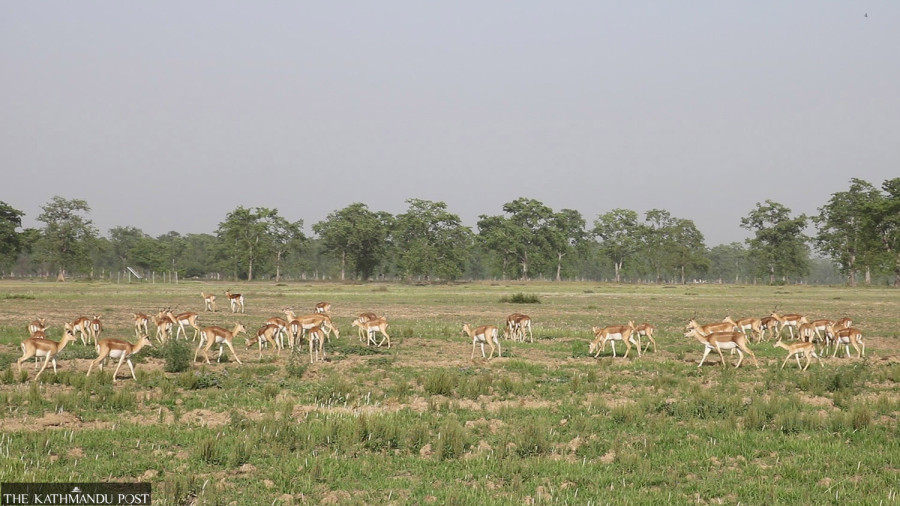Lumbini Province
Marginal rise in blackbuck population in conservation area worries experts
A count conducted this month found 190 blackbucks in the Khairapura Blackbuck Conservation Area. Their number last year was 177.
Kamal Panthi
The recent blackbuck count showed a small increase in the population of blackbucks (Antilope cervicapra), locally called Krishnasar, in Khairapura-based blackbuck conservation area in Gulariya Municipality-2 raising questions about the effectiveness of conservation efforts.
The blackbuck population has not increased as expected mainly due to attacks by leopards, hyenas and stray dogs, say conservationists.
The fresh blackbuck count conducted during the national wildlife week, which is celebrated in the first week of the Nepali New Year, found 190 blackbucks in the conservation area. According to conservation officer Binaya Jha, there are 114 female blackbucks, 40 male blackbucks and 36 fawns.
Last year’s count had put the blackbuck population at 177 in the conservation area.
“There is only a slight increase in blackbuck population. The result of the count is not satisfactory. It goes to show that we have to resolve various challenges afflicting blackbuck conservation,” said Dipendra Yadav, chairman of the Blackbuck Conservation Committee.
In 2014, the blackbuck population in the conservation area stood at 300. The blackbuck number has declined over the years due to various challenges. Frequent attacks by leopards and striped hyenas is the main challenge in the conservation of blackbucks. According to the conservation authority, leopards and hyenas from various forests in Tulsipur and Bechaipur visit the conservation area in search of prey and kill blackbucks.
The data available at the blackbuck conservation area shows a total of 85 blackbucks were either killed or died of natural causes in the past year. Among them, 65 were killed by leopards while others were killed by hyenas, jackals, stray dogs or died due to natural causes.
The monsoons also bring about a challenge in the conservation of the blackbucks in the area that has several streams passing through it. Floods in the local streams and rivers have also added to the death toll of the blackbucks.
As many as 40 blackbucks were swept away by the floods in local streams in 2014 while the floods in 2018 killed 19 blackbucks.
Blackbuck, which is listed as near-threatened by the International Union for Conservation of Nature, is an antelope species native to Nepal and India. A female blackbuck generally gives birth to two fawns each year.
Efforts for blackbuck conservation began in the country in 1975 when a small herd was spotted in Khairapura in Bardiya district. On March 16, 2009, the government officially declared the area as ‘Khairapura Blackbuck Conservation Area’ spreading over 708 bighas [474 hectares] of land.
The presence of human settlement in the conservation area has also posed a threat to the survival of blackbucks, say conservationists. The government acquired around 350 bighas [234.5 hectares] of land in the Khairapura area for blackbuck conservation around 10 years ago. “Fifty-one families have yet to move out of the area even after receiving compensation for their land, which was acquisitioned by the government,” said Yadav.




 8.12°C Kathmandu
8.12°C Kathmandu












%20(1).jpg&w=300&height=200)

